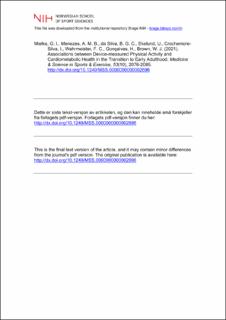| dc.contributor.author | Mielke, Gregore I. | |
| dc.contributor.author | Menezes, Ana Maria B. | |
| dc.contributor.author | da Silva, Bruna Gonçalves Cordeiro | |
| dc.contributor.author | Ekelund, Ulf | |
| dc.contributor.author | Crochemore-Silva, Inacio | |
| dc.contributor.author | Wehrmeister, Fernando César | |
| dc.contributor.author | Gonçalves, Helen | |
| dc.contributor.author | Brown, Wendy J. | |
| dc.date.accessioned | 2022-11-22T13:48:40Z | |
| dc.date.available | 2022-11-22T13:48:40Z | |
| dc.date.created | 2022-02-23T10:05:05Z | |
| dc.date.issued | 2021 | |
| dc.identifier.citation | Medicine & Science in Sports & Exercise. 2021, 53(10), 2076-2085. | en_US |
| dc.identifier.issn | 0195-9131 | |
| dc.identifier.uri | https://hdl.handle.net/11250/3033448 | |
| dc.description | I Brage finner du siste tekst-versjon av artikkelen, og den kan inneholde ubetydelige forskjeller fra forlagets pdf-versjon. Forlagets pdf-versjon finner du på journals.lww.com / In Brage you'll find the final text version of the article, and it may contain insignificant differences from the journal's pdf version. The definitive version is available at journals.lww.com. | en_US |
| dc.description.abstract | Purposes: The aims of this study were to investigate the cross-sectional and prospective associations between accelerometer-measured physical activity and cardiometabolic health in the transition to adulthood. Methods: Data from the 1993 Pelotas (Brazil) Birth Cohort were analyzed (n = 2280). Moderate-to-vigorous intensity physical activity (MVPA) (measured using a triaxial accelerometer) and cardiometabolic health (total fat mass, blood glucose, non-high-density lipoprotein cholesterol, triglycerides, and mean resting blood pressure) were examined at age 18 and 22 yr. Results: Overall, inverse dose–response associations between MVPA and cardiometabolic health at age 18 and 22 yr were observed in cross-sectional analyses of data from men and women. Prospective analyses showed that, in general, MVPA declined, and cardiometabolic health worsened in this 4-yr period in both men and women. Cardiometabolic health at age 22 yr reflected both MVPA at age 18 yr (β, −0.007; 95% confidence interval [CI], −0.014 to 0.000) and changes in MVPA from 18 to 22 yr (β, −0.030; 95% CI, −0.043 to −0.016) in men, but only changes in MVPA in women (β, −0.035; 95% CI, −0.058 to −0.011). In analyses of change over time, men who improved MVPA by 20 to 30 min·d−1 showed significant improvements in cardiometabolic health over 4 yr. The magnitude of association was slightly stronger for MVPA in 10-min bouts than for MVPA accumulated in bouts of 1 min, especially in women. Conclusions: Moderate-to-vigorous intensity physical activity is an important predictor of cardiometabolic health in early adulthood. Strategies to prevent declines in MVPA at this life stage are required to prevent deteriorating cardiometabolic health profiles. | en_US |
| dc.language.iso | eng | en_US |
| dc.subject | physical activity | en_US |
| dc.subject | cohorts | en_US |
| dc.subject | adulthood | en_US |
| dc.subject | metabolic profile | en_US |
| dc.title | Associations between Device-measured Physical Activity and Cardiometabolic Health in the Transition to Early Adulthood | en_US |
| dc.title.alternative | Associations between Device-measured Physical Activity and Cardiometabolic Health in the Transition to Early Adulthood | en_US |
| dc.type | Peer reviewed | en_US |
| dc.type | Journal article | en_US |
| dc.description.version | acceptedVersion | en_US |
| dc.source.pagenumber | 2076-2085 | en_US |
| dc.source.volume | 53 | en_US |
| dc.source.journal | Medicine & Science in Sports & Exercise | en_US |
| dc.source.issue | 10 | en_US |
| dc.identifier.doi | 10.1249/MSS.0000000000002696 | |
| dc.identifier.cristin | 2004751 | |
| dc.description.localcode | Institutt for idrettsmedisinske fag / Department of Sports Medicine | en_US |
| cristin.ispublished | true | |
| cristin.fulltext | postprint | |
| cristin.qualitycode | 2 | |
